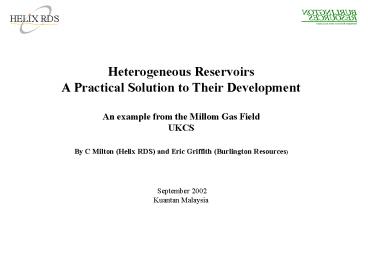Heterogeneous Reservoirs - PowerPoint PPT Presentation
1 / 32
Title:
Heterogeneous Reservoirs
Description:
An example from the Millom Gas Field. UKCS ... Aeolian Sands. Flat Generic Porosity Model. HELIX RDS. Dipping Generic Facies Model. HELIX RDS ... – PowerPoint PPT presentation
Number of Views:814
Avg rating:5.0/5.0
Title: Heterogeneous Reservoirs
1
Heterogeneous Reservoirs A Practical Solution to
Their Development An example from the Millom Gas
Field UKCS By C Milton (Helix RDS) and Eric
Griffith (Burlington Resources) September
2002 Kuantan Malaysia
2
Millom Field, East Irish Sea, Location
3
Millom Field Top Structure Map w. Well Locations
113/26a-1
113/27a-4
113/26a-2
113/27a-3
1Km
4
Millom Field Reservoir Characteristics
Sherwood Sandstone Formation Age
Triassic Depth 4000 - 6000 ft
TVDSS Porosity Range 2 - 18 pu (2 -
24pu) Permeability Range 0.001 - 100mD (1000 -
5000mD) Reservoir/Rock Type Thinly bedded muds
and sandstones
50ft
5
Problems and Uncertainties
- Major Problems
- Time constrained.
- Very finely laminated nature of the Field.
- High contrast in permeabilities.
- Location, size and orientation of Dune Bodies.
- Major Uncertainties
- Untested GWC in Millom West.
- KV/KH Ratio.
- Type of well design.
6
Millom Field Development Timing
Field Development Approval Platform Contract Award
7
Objectives of Development Study
- Optimise both type and number of wells for the
possibly varied and difficult reservoir
conditions. Ultimately to provide upfront slot
requirements for the platform design and well
paths. - To achieve this
- Develop a quick screening method for the well
type - Consistent picture of the Millom reservoir using
all the available data - Build a full field simulation model
8
Generic Modelling
9
Fast Track/Up Front Well Selection
- Process of selecting the optimal well type
- Commercial Construction Time Drivers Impacted
this process - Potentially expensive wells.
- Platform / template slot Nos.
- Required multi-tracking of activities
implementing a screening process - Building of generic geological models
- Testing various well types in these models to
determine - Productivity of different wells types
- Cost of wells
- Deriving an NPV for each well type
10
Generic Model Types
Flat Grid
Dipping Grid
Flat models represent Millom East Three
separate models one based on each well Each of
these models had different sized dune
bodies Total Models 6
Dipping models represent Millom West One well
model based on the 26a-1 well Each of these
models had different sized dune bodies Each
model has dunes parallel or perpendicular to
dip Total Models 4
11
Flat Generic Facies Model
Aeolian Sands
Modeled Well
200ft
12
Flat Generic Porosity Model
Aeolian Sands
Modeled Well
200ft
13
Dipping Generic Facies Model
14
Dipping Generic Porosity Model
15
Well Types
- 13 Different Well Types Considered for Selection
16
Generic Well Modelling (Vertical Wells)
17
Generic Well Modelling (Trilateral Wells)
18
Project Work Flow
Fast track well type selection
Build Generic Models
10 Different Models
Number of simulation runs
Well optimisation
Seismic Interpretation
13 Different Well Types 9 Different Locations
1170
Results
One Month Initial Production run Min/Max/mean
well positions chosen Mean Well location run for
20years
100
Full Field Model
Structural Surfaces
Plan Wells
Upscale Simulate
19
Generic Well Performance (All Well Types)
Flat Model
10s mmscf/d
20
Generic Well Performance (All Well Types)
Dipping Model
10s mmscf/d
Well Type
21
Well NPVs (All Well Types)
The expected value incorporates both cost and
production uncertainty
Increasing NPV
22
Well Selection Conclusions
- Most productive well types
- Tri-lateral
- Horizontal Fractured
- Dual-lateral
- Best well types contact most reservoir section
- Chosen well design
- Dual Lateral
- Encompasses security of supply (more well bores
to surface) in comparison to Tri Laterals - less technical risk than Tri Laterals
- Fracturing well adds significant risk
- Underbalanced drilling only shows slight
improvement in horizontal wells
23
Well Design Planning
24
Well Planning Work Flow Process
- Previous Approach
- New Approach
Directional
GG/RE
Sperry
HRDS/BURL
GG/RE
M/D Team
Directional
Completions
Drilling
Completions
GMIS/Baker
HRDS/Baker
Drilling
Different disciplines in different locations
leads to an increase in communication time and
hinders a common understanding of objectives and
constraints.
Different disciplines in same location leads to
instant communication and a common understanding
of inter disciplinary objectives and constraints.
25
Millom West Development Well Locations Top
Ormskirk Depth Structure Map ft. tvdss
26
Eastern Multilateral Well
Well cuts down through heterogeneous upper
section to point 100ft vertcally above the OWC
and then cuts back up through the latyers to
provide a tie point at the toe of the well.
Tie point
27
Western Multilateral Well
Structural control point at toe
100ft Stand off
FWL
28
Conclusions
- The heterogeneous nature of the reservoir
required careful consideration when choosing a
well design type to optimally exploit the
reserves. - Establishing well design prior to full field
model build is very time efficient. The use of
generic models has proven the technique on Millom - There is enormous benefit in using the model,
both Generic and Full Field, to provide a shared
vision for all interested parties. - The ability to quickly provide a sample model of
part of the field is a valuable learning tool for
both geologist and reservoir engineer.
29
Acknowledgements
Helix RDS would like to thank Burlington
Resources (Irish Sea) Limited for permission to
use the material in this presentation.
30
(No Transcript)
31
(No Transcript)
32
(No Transcript)































